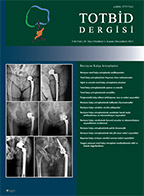
Total hip arthroplasty is a frequently performed and a successful surgical procedure in advanced hip osteoarthritis. Although it is a successful surgical procedure, periprosthetic joint infection (PJI) is one of the most serious complications. The aim of this review article is to review the diagnosis and treatment options in periprosthetic hip joint infection in the light of current information. Appropriate management of periprosthetic hip joint infection is possible with clinical suspicion, accurate diagnosis, and successful treatment steps, each of which is challenging. Hip PJI is diagnosed by a combination of clinical signs and symptoms, biochemical tests, imaging modalities, synovial fluid analysis, histological and microbiological analyses, and diagnostic criteria. There are 5 main treatment options in the management of infected hip arthroplasty: `suppression with antibiotics`, `debridement, irrigation, and retention of the prosthesis`, `one-stage revision`, `two-stage revision` and `salvage procedures (resection arthroplasty and amputation)`. The best management of this condition, which can cause serious morbidity and even mortality, is possible if the surgeon is alert and well-informed about hip PJI, closely following the developments in diagnosis and treatment, besides being careful and meticulous in this difficult and long process.